LeapSecond.com
FE-405B DDS-based DOCXO
02-Jun-2014
Performance plots
The following are results comparing two 15 MHz FE-405B DOCXO
(double ovenized) quartz crystal oscillators against each other.
Some of these oscillators exhibit stability well below 1×10-12 over a narrow range of tau.
For contrast, in this report,
a pair of free-running TBolts (Trimble Thunderbolt GPSDO) is also included.
The 10 MHz TBolt OCXO are well-known among time/frequency enthusiasts
for their excellent phase noise and frequency stability.
All of these oscillators had stabilized for many weeks prior to data collection.
ADEV plot
In general the TBolt has significantly better performance for sub-second tau;
the FE405B has better performance for tau 1 to 30 seconds.
Performance for tau beyond half a minute is partly indicative of frequency drift.
It is not uncommon for TBolt to show 2×10-12 performance out to 1000 seconds or more.
The FE405 have especially stellar performance in the 1 to 10, or 1 to 100 second range.
The dip into 10-13 territory is deep but rather short lived.

TDEV plot
A TDEV plot is a better predictor of how well the oscillator will perform as part of a GPSDO.
Here we see both oscillators are within a factor of two of each other,
trading off who is slightly better over different ranges of tau.

Phase plots
Plots like these tend to vary run to run, or day to day so they should not be taken too seriously.
But they do show that over 5 hours, the phase residuals are still well within 10 ns.
The quadratic appearance of both traces suggests linear frequency drift.
In this case the TBolt drift is about half as much as the FE405 drift.

Frequency plots
As hinted by the different-shaped ADEV plots, the noise character of each oscillator is slightly different.
The following are some frequency-series plots, with 1 and 100 second averaging.
The final plot shows raw data, collected at 100 Hz and no averaging.
As expected given the left edge of the ADEV plots, the DDS-based FE405 has ten times more noise.





Phase Noise
In the range of 1 Hz to 500 Hz the TBolt has far better phase noise, by as much as 30 dB.
However, out at 10 kHz and 100 kHz, a pair of FE405B hits -170 dBc/Hz, which is impressive.

Variation in FE-405B
The following plots shows 4 different FE-405B oscillators (H-maser reference).
One of them is exceptionally poor;
one is really nice;
the difference between the best and worst is a factor of 100.

TODO:
Add a few more oscillators to the testbed.
Debug the sub-standard one.
Glitches in FE-405B
The FE-405B is quite unique in its design (see patent 6577201).
For frequency tuning, a high-resolution DDS is used instead of conventional varactor (varicap) diode-based,
analog EFC (electronic frequency control).
This means the quartz oscillator is permanently free-running and the chosen frequency output
or any frequency adjustment is implemented with DDS magic over the serial port.
It might also explain the poor sub-second short-term performance and
explain a series of very odd glitches seen in some FE-405B that were tested.
A modern DDS has both a frequency tuning word and a phase advance word.
It is possible to implement very fine-frequency tuning by alternating
among multiple frequencies (like PWM) or by programmed periodic phase steps.
While these tricks look good on paper, and while they do give fine average frequency tuning,
it comes at the cost of instantaneous jumps in frequency and/or phase
that are only visible if you look closely.
Applications using digital oscillators like this need to be very careful about these artifacts.
Here are some examples where jumps on the order of 3×10-12 occur.
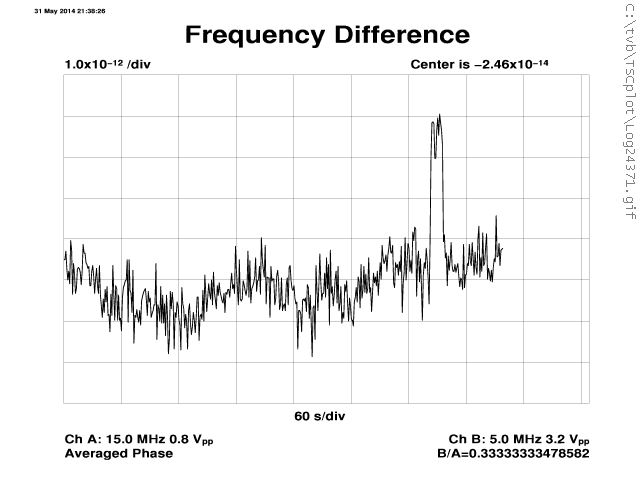
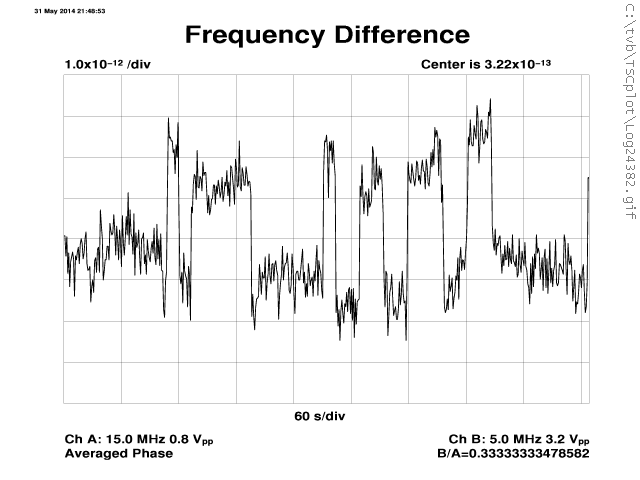
TODO:
See if the glitches correlate to frequency tuning values.
See why one FE405B shows no glitches.
See if these jumps are an attempt at 2nd order temperature compensation.
Conclusion
The FE-405B is compact high-performance DDS-based DOCXO with RS232 digital frequency tuning and 15 MHz output.
The high-resolution digital tuning simplifies the use of this device
as a programmable frequency generator
or as the LO in a GPSDO.
Several units tested showed impressive short-term stability down in the mid 10-13 range.
The use of a DDS may explain excessive glitches in some of the units.
The observed quantized frequency hopping jumps are not found in any normal (non-DDS-based) oscillator.
While the mid-frequency phase noise is quite poor,
the high-frequency phase noise floor is unusually low.
DDS PLL
Inside the FE405B are both an elaborate 5.x MHz DOCXO and a plain 15 MHz XO.
The DOCXO is heated on all 6 sides with power transistors.
The XO is thermally glued to outside of the massive hot copper outer oven.
Surprisingly, the DOCXO has only three pins: +10 VDC power, ground, and a low power 5.x MHz RF output.
It is not on-frequency, nor is it manually or electrically tunable.
The other key component is a AD9852 DDS, which has 48-bit frequency tuning and 14-bit phase offset resolution.
Interestingly, the DDS is not used to directly synthesize the 15 MHz RF output.
Instead the 15 MHz output is derived directly from the 15 MHz XO (configured as a VCXO)
and the XO is steered by a PLL.
The uncalibrated, unsteered, but very stable DOCXO is used only to clock the DDS.
The 15± MHz output of the DDS is used as the reference for the PLL.
Note the usual DDS noise is lost in the mixer, phase detector, and low pass filter of the PLL.
Thus the 15 MHz output of the FE405B is as pure as a crystal, as stable as a DOCXO,
and precisely digitally adjustable in frequency.
The FE405B uses +15 VDC and +5 VDC.
It turns out that one can disable the DDS+PLL by simply removing the +5 VDC.
When this is done the output is only the 15 MHz XO.
Thus without even opening the unit, we can explore how the internal PLL works.
The following plots illustrate this fact.
Below we see that the "hump" is about 0.01 s and the "cross-over" is about 0.1 s.
This is just like the PLL of a GPSDO, but at a much shorter timescale.
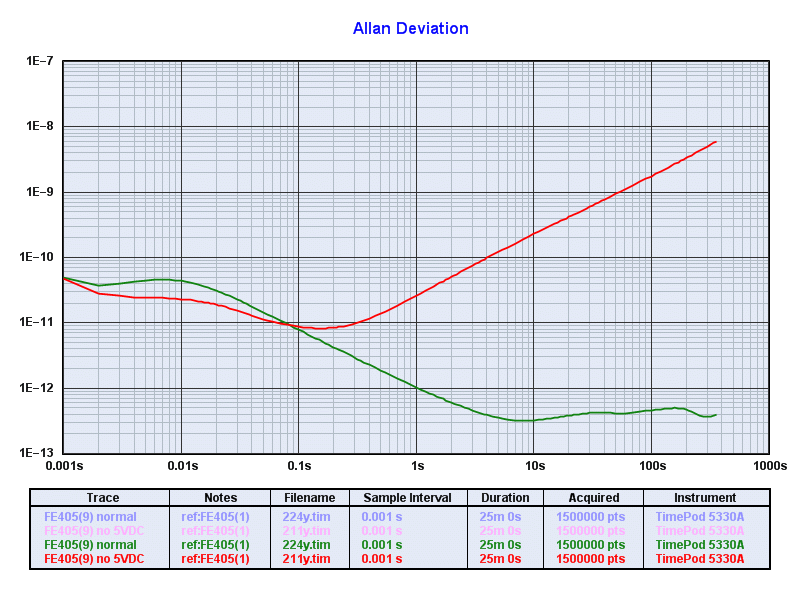
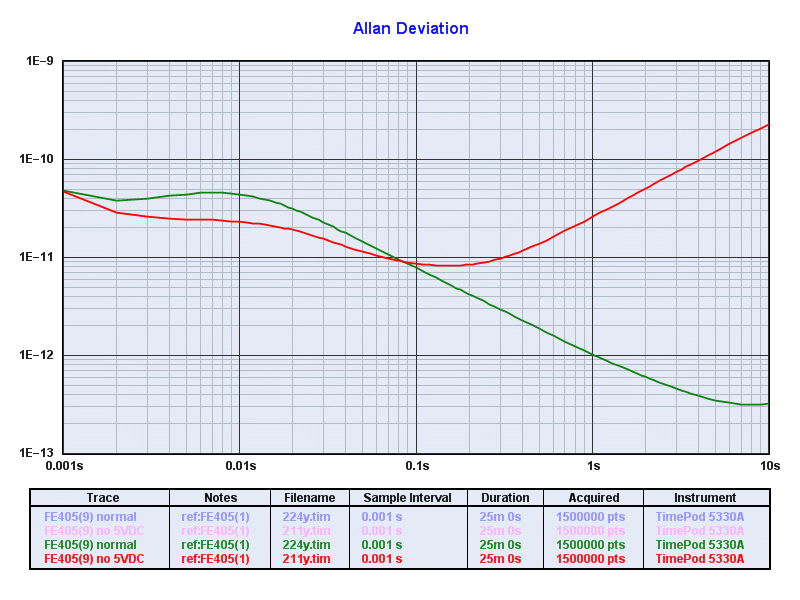
In the phase noise plot below we see the XO has better performance than the DOCXO.
Note also the strong spurs at around 200 Hz and 4200 Hz.
Perhaps this is related to the PLL or DDS frequency or phase word update rate.
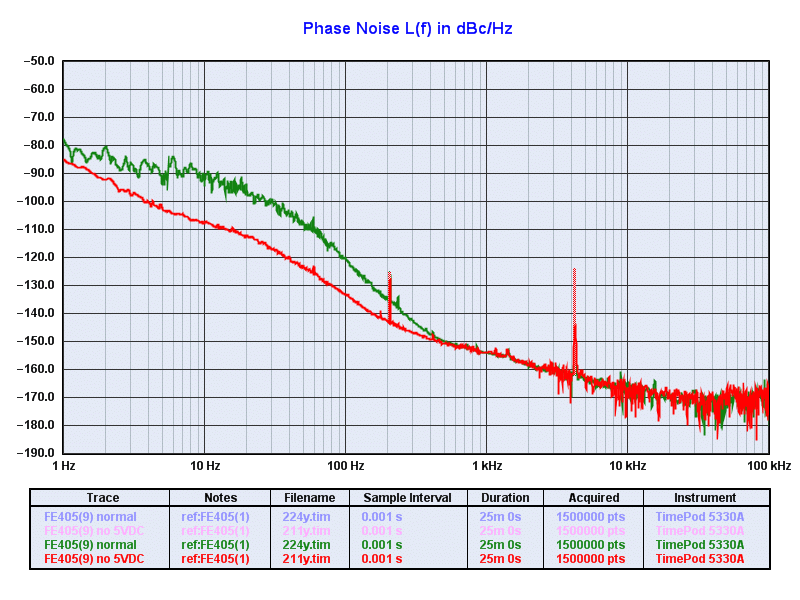
The following frequency plots are another way to illustrate
how the XO is more stable than the DOCXO short-term,
but also that the DOCXO is far more stable than the XO long-term.
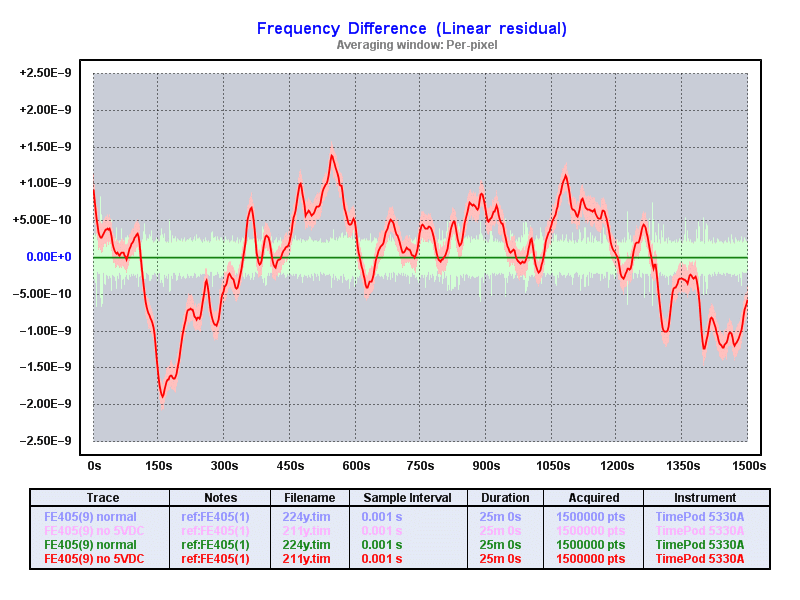
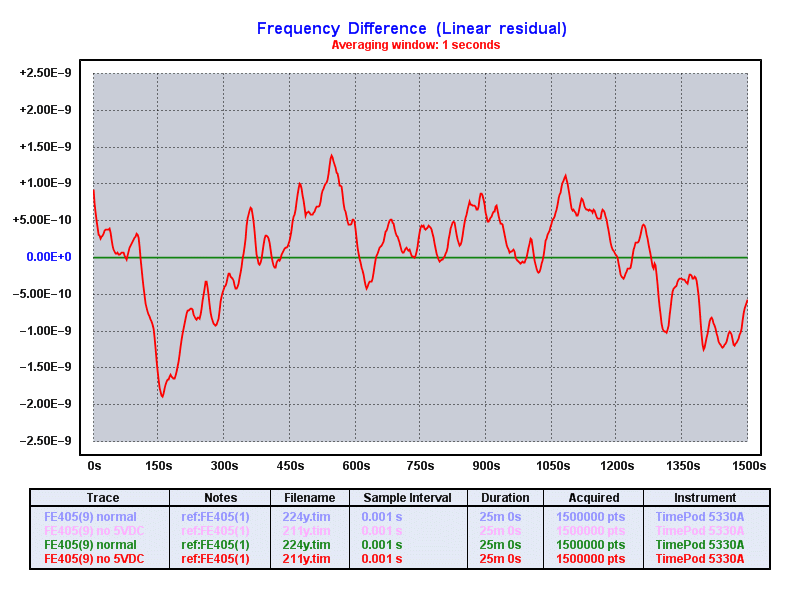
Finally, here are ADEV plots using the "trace history" technique,
zooming in on the 1 ms to 1 s range of tau.
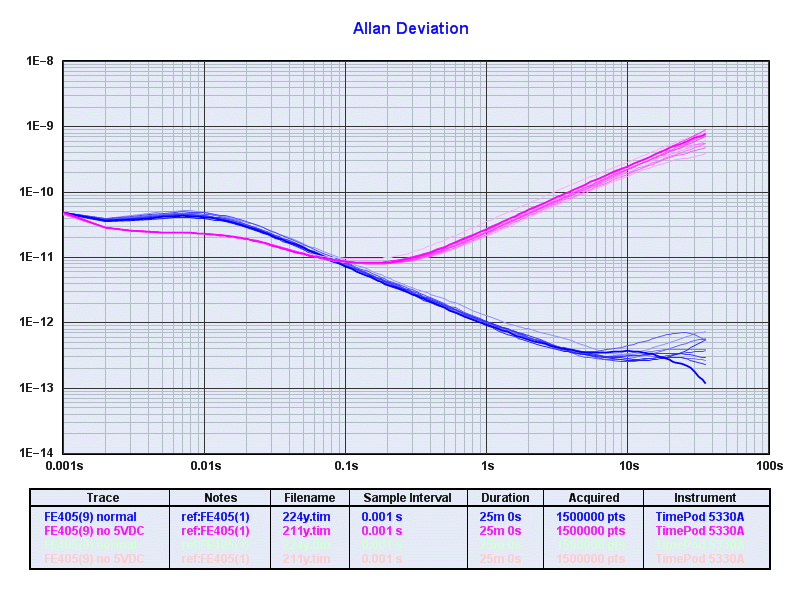
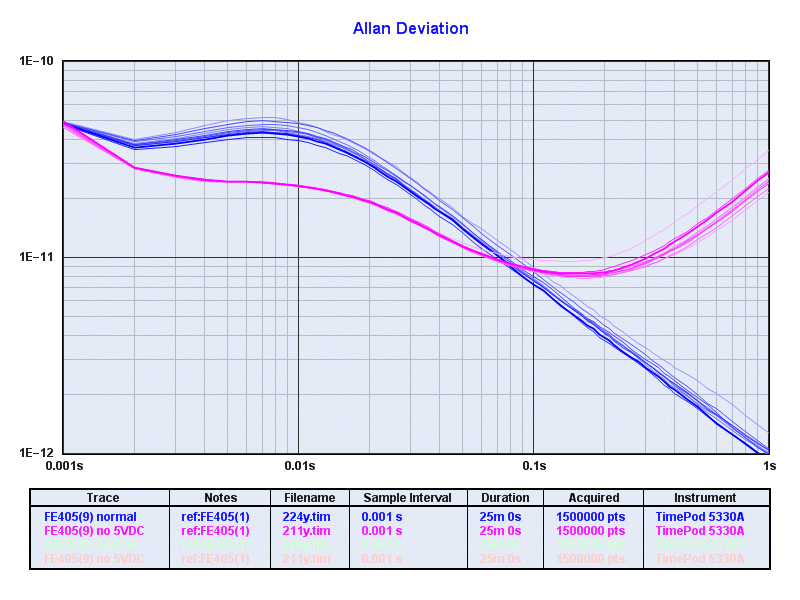
FEI information
The following are from Tutorial on Precision Frequency Generation,
filename precision_frequency_generation.pdf (google for it).
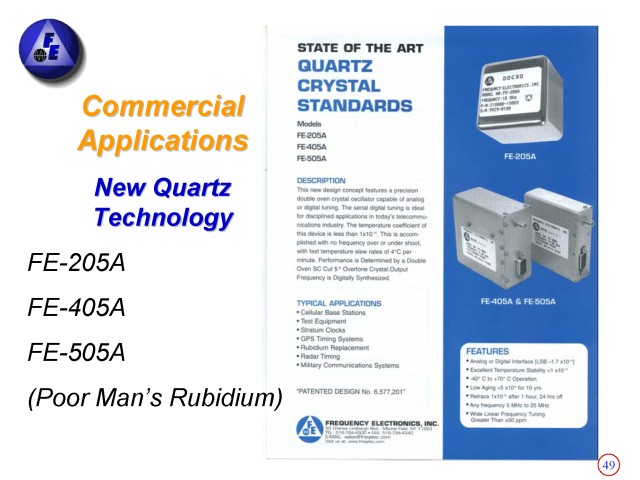
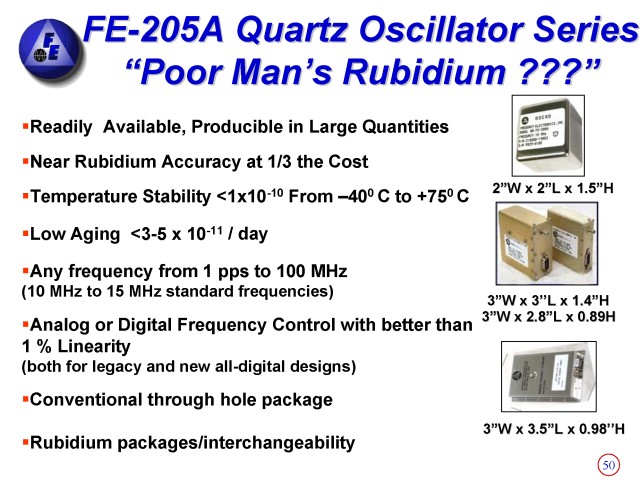
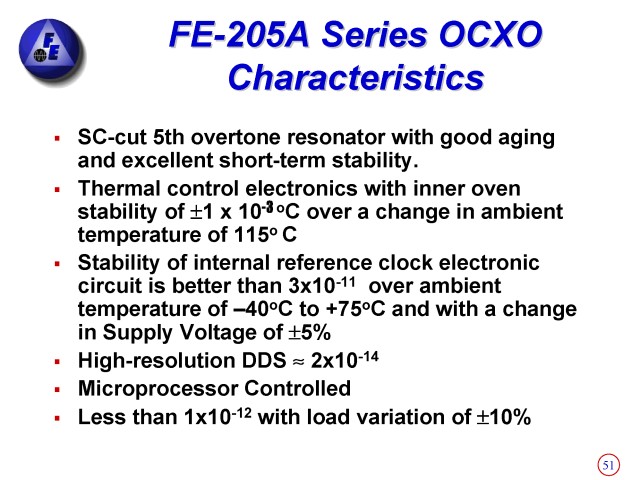
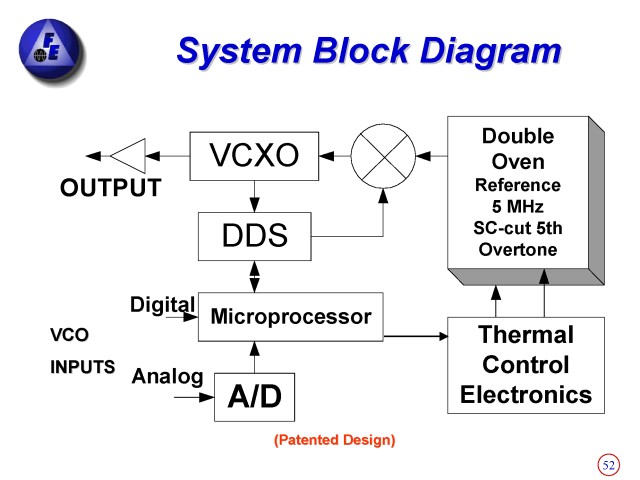
FEI Patents
The FEI patent(s) for Precision oven-controlled crystal oscillator make good reading:
Return to LeapSecond.com home page.
Comments/questions to tvb.






















